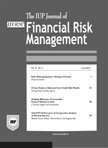|

June'12 |
Focus
The present issue brings forth three papers. The first paper, “A Review of Real
Option Practices Followed by Corporate for Expansion and Deferral Decision”, by
Urvashi Varma, tries to capture different types of real options and their valuations.
|
|
|
Articles |
| |
Early Warning Systems: Testing in Practice
-- Aneta Krstevska
Creation and use of the Early Warning Systems (EWS) in practice are relatively new, and therefore, there is a need for their further development. Although not being perfect, they proved to be a useful tool for foreseeing the risk of potential crisis. Similar to the macroeconomic models, they need to be updated with new data and new variables which are confirmed by the world experiences for valuable signaling effects of potential crisis. However, there are indicators which are non-observable, confirming thereby the complexity of the topic. Having in mind these considerations, the EWS remain important and they will attract more attention from the academics and experts worldwide. This paper describes the general usefulness of the EWS, especially in the case of the Macedonian economy, from the viewpoint of the last world financial crisis by applying different approaches for their construction.
© 2012 IUP. All Rights Reserved.
A Case Study on Reduced Form Credit Risk Models
-- Ya-Ting Hsieh and Shu-Ing Liu
This is a case study on the credit risk models, introduced by Cetin et al. (2004) and Guo et al. (2009). Empirical analyses are focused on the pricing of zero-coupon bonds issued by two US industrial companies, the Coca-Cola Company and PepsiCo Inc. Applying market observed information, simulations of some related variables are performed, and then the future zero-coupon bond prices for each discussed model are generated. The results indicate that during the financial tsunami influence period, due to the fact that the former model, i.e., Jarrow04, considers bond publisher’s cash reserves and immediately responds to market information, better predictions are obtained from it. However, in the period after the financial crisis, the latter model, i.e., Jarrow09, performs better for pricing a long-term zero-coupon bond, while for a short-term bond, the former performs slightly better.
© 2012 IUP. All Rights Reserved.
Hedging Efficiency of Commodity Futures Markets in India
-- C Hussain Yaganti and B Kamaiah
The present study investigates the hedging effectiveness of commodity futures contracts for spices and base metals by employing cointegration and error correction methodology with different maturity time horizons varying from one month to three months, i.e., maturity month, nearby month and far month. The optimal hedge ratios are calculated from Ordinary Least Squares (OLS) regression and Error Correction Model (ECM). It is found that the futures market dominates in price discovery in nearby month contracts. In far month contracts, there is no long-term relationship between spot and futures prices for turmeric and cardamom. In case of base metals, futures market leads spot market for all the three contracts. This study supports that futures price representing the collective market opinion is considered as reference price for spot market players like traders, farmers and other stakeholders in commodity trading domain. Hedging effectiveness is also measured at various maturity periods. The results suggested that only 40% of contracts are suitable for hedging. It is generally found that there is no significant difference in hedging performance between far month and nearby month maturity periods for spices, while in the case of base metals slight variation is seen in hedging performance among different maturity periods. Further, there is not much difference in the estimates of hedging effectiveness obtained from OLS method and ECM. It is found that for far and nearby maturity periods hedging is more effective, which has some important implications for hedging strategy. These findings are helpful to risk managers, farmers, stakeholders and policy makers.
© 2012 IUP. All Rights Reserved.
Gold ETF Performance: A Comparative Analysis of Monthly Returns
-- Mukesh Kumar Mukul, Vikrant Kumar and Sougata Ray
Gold investment has been a very important aspect for ages across the globe. This paper attempts to analyze the performance of gold Exchange-Traded Fund (ETF) with respect to risk and return against the diversified equity fund and market portfolio. It also examines the role of gold in hedging equity investment risk. The study is based on data for the period from January 2010 to August 2011. The analysis shows that gold ETF has given good return in comparison to a diversified equity fund during the study period.
© 2012 IUP. All Rights Reserved.
|


